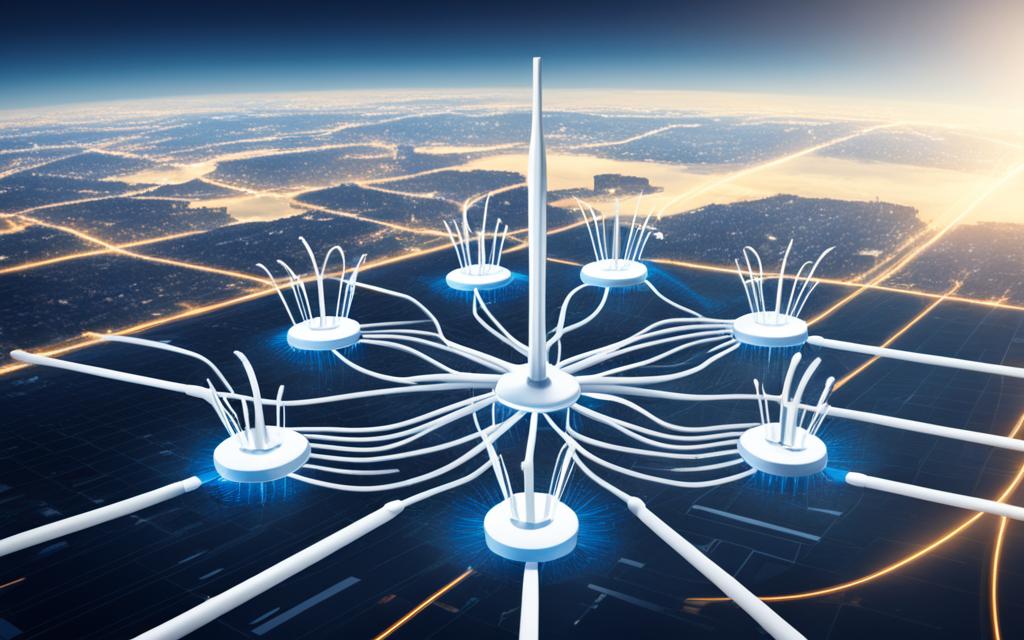MIMO technology, also known as Multiple Input, Multiple Output, plays a vital role in modern cellular networks, revolutionizing data speeds and enhancing connectivity reliability. By utilizing multiple antennas at both the source and destination, MIMO enables devices to transmit and receive multiple signals simultaneously, resulting in increased capacity and improved efficiency of cellular communications.
With MIMO technology, users can experience faster data speeds and stronger connections, allowing for seamless browsing, streaming, and communication. This technology has significantly contributed to the evolution of cellular networks, ensuring a better wireless connectivity experience for all.
In this article, we will delve deeper into MIMO technology, its applications in cellular networks, the advantages of MIMO antennas, and how they can be used in various settings. Understanding MIMO technology is essential for maximizing cellular speeds and harnessing the power of reliable wireless connectivity.
Understanding MIMO in Cellular Networks
In cellular networks, MIMO technology plays a fundamental role in both 4G/LTE and 5G systems, as well as Wi-Fi networks. This advanced technology utilizes multiple antennas to enhance data transfer capabilities, resulting in faster speeds and stronger connections for users.
Most modern mobile devices, including smartphones and hotspots, are equipped with multiple cellular antennas that leverage the power of MIMO technology. Similarly, cell towers are equipped with multiple antennas that work in harmony to communicate with devices. The more antennas a device or cell tower has, the better the data transmission speed and reliability.
MIMO configurations can vary, ranging from 2×2 to 8×8, depending on the device and network capabilities. This signifies the number of antennas employed in the MIMO setup. Higher MIMO configurations, such as 4×4 or 8×8, can significantly improve the performance of cellular networks, allowing for faster speeds and stronger connections.
By utilizing MIMO technology and deploying an adequate number of antennas, both the device and cell tower can transmit and receive multiple signals concurrently, increasing the capacity and efficiency of cellular communications.
With MIMO technology, users can benefit from:
- Enhanced data transfer speeds
- Improved network coverage
- Reduced latency
- Increased network capacity
- Stable and reliable connections
The use of MIMO technology is instrumental in meeting the ever-increasing demand for faster and more reliable wireless connectivity. As cellular networks continue to evolve, MIMO technology will play a crucial role in delivering enhanced user experiences.
Advantages of MIMO Antennas
MIMO antennas play a critical role in optimizing cellular network performance by enabling the transmission and reception of multiple data streams simultaneously. This advanced technology offers several key advantages that significantly enhance the user experience, including faster data speeds, a stronger signal, reduced interference, and improved reliability.
Faster Data Speeds
With MIMO antennas, users can enjoy faster data speeds when accessing cellular networks. By harnessing the power of multiple antennas, MIMO technology maximizes the capacity and efficiency of data transmission, enabling quicker downloads, smoother video streaming, and faster browsing.
Stronger Signal Reception
MIMO antennas enhance signal reception by utilizing multiple antennas to capture signals from different paths. This multi-antenna system effectively mitigates signal degradation caused by obstacles or interference, resulting in a stronger and more reliable connection. Whether users are in urban areas with high network traffic or rural regions with weak signals, MIMO antennas ensure consistent signal strength.
Reduced Interference
MIMO antennas are designed to reduce interference from other wireless devices or environmental factors. By leveraging the spatial diversity offered by multiple antennas, MIMO technology can effectively discriminate against unwanted signals and minimize radio frequency (RF) noise interference. This reduction in interference further enhances the quality and reliability of wireless communications.
Improved Reliability
One of the significant benefits of MIMO antennas is the improved reliability they provide to cellular network connections. By leveraging diversity in signal propagation, MIMO technology can overcome issues such as fading and shadowing, which can cause disruptions in the connection. This improved reliability ensures a stable and uninterrupted wireless experience for users.

“MIMO antennas optimize received signals, minimize RF noise interference, and improve the overall visual and auditory quality of wireless communications.” – Industry Expert
Overall, MIMO antennas are a game-changer for cellular networks, offering faster speeds, a stronger signal, reduced interference, and improved reliability. By harnessing the power of MIMO technology, users can enjoy enhanced connectivity experiences, whether they are streaming content, browsing the web, or making voice and video calls.
Using MIMO Antennas in Different Applications
MIMO antennas offer versatile solutions for improving wireless connectivity in various applications. Whether it’s in homes, offices, commercial buildings, vehicles, or boats, MIMO antennas can enhance signal reception and promote seamless communication.
When it comes to achieving optimal performance and coverage, the type and configuration of the MIMO antenna are important considerations. In areas with weak signals, directional MIMO antennas are ideal as they provide greater gain and can be pointed towards the nearest cell tower. On the other hand, for areas with moderate to strong cellular signals, omnidirectional MIMO antennas capture signals from all directions and offer a wider coverage range.
Here’s a breakdown of how MIMO antennas can be effectively utilized in different applications:
Homes
In residential settings, MIMO antennas can be installed to boost wireless connectivity and improve data speeds. With the increasing number of connected devices in modern households, MIMO technology ensures that everyone can enjoy a reliable and fast internet connection. By strategically positioning MIMO antennas, dead spots and weak signal areas can be minimized, creating a seamless browsing and streaming experience for all family members.
Offices
Offices often house numerous employees and require uninterrupted connectivity for seamless communication and efficient work processes. MIMO antennas can be deployed to enhance the wireless network infrastructure, ensuring smooth data transfer and reliable connectivity throughout the office space. By strategically placing MIMO antennas, businesses can minimize network disruptions, enhance productivity, and facilitate collaborative work environments.
Vehicles
MIMO antennas are increasingly being integrated into vehicles, including cars, trucks, RVs, and boats, to enable reliable mobile connectivity on the go. Whether it’s for navigation, entertainment, or communication purposes, MIMO antennas enhance signal reception even in remote areas, ensuring a stable internet connection for passengers. This allows for uninterrupted streaming, real-time navigation updates, and seamless connectivity throughout the journey.
Commercial Buildings
In commercial buildings, such as shopping malls, hotels, and airports, MIMO antennas play a crucial role in providing reliable wireless connectivity to a large number of users simultaneously. By strategically installing MIMO antennas throughout these buildings, signal coverage is extended, ensuring seamless internet access for visitors and customers. MIMO antennas help businesses create a positive user experience, encourage customer satisfaction, and support a wide range of wireless applications within the commercial space.
In conclusion, MIMO antennas offer versatile solutions for improving wireless connectivity in various applications. Whether it’s in homes, offices, vehicles, or commercial buildings, the right choice of MIMO antenna can enhance signal reception, strengthen connectivity, and provide a seamless wireless experience. By harnessing the power of MIMO technology and deploying the appropriate MIMO antennas, users can enjoy reliable connectivity, faster data speeds, and enhanced wireless performance in their respective environments.
Conclusion: Harnessing the Power of MIMO Technology
MIMO technology has revolutionized cellular networks, enabling faster data speeds and more reliable connectivity. By utilizing multiple antennas to transmit and receive signals simultaneously, MIMO technology enhances the capacity and efficiency of cellular communications. With MIMO, users can experience faster speeds, stronger signals, and improved reliability in their wireless connectivity.
While cellular boosters have their benefits, MIMO antennas offer unique advantages. Unlike boosters, which amplify existing signals, MIMO antennas actively optimize and enhance the wireless connection. By transmitting and receiving multiple signals, MIMO antennas increase the capacity of cellular networks and improve data transfer rates.
Understanding MIMO technology and using the right MIMO antenna can significantly enhance cellular speeds and provide a better wireless connectivity experience. Whether you’re in a home, office, or vehicle, investing in MIMO technology can ensure that you enjoy faster data speeds, stronger signals, and improved reliability in your cellular network connections. Say goodbye to slow downloads and buffering videos – embrace the power of MIMO technology today.
FAQ
What is MIMO technology?
MIMO technology, short for Multiple Input, Multiple Output, is a crucial component in modern cellular networks. It uses multiple antennas at both the source and destination to improve data transfer reliability and speed.
How does MIMO technology enhance cellular networks?
MIMO technology allows devices to transmit and receive multiple signals simultaneously, increasing the capacity and efficiency of cellular communications. This technology enables faster data speeds and enhances connectivity reliability.
Where is MIMO technology used?
MIMO technology is fundamental to both 4G/LTE and 5G systems, as well as Wi-Fi networks. It is used in most modern mobile devices, including smartphones and hotspots, as well as in cell towers to communicate with devices.
How do MIMO antennas improve cellular network performance?
MIMO antennas are specially designed to send and receive multiple data streams simultaneously, resulting in faster data speeds, stronger signal reception, and reduced interference from other wireless devices or environmental factors.
What types of MIMO antennas are available?
MIMO antennas can be directional or omnidirectional. Directional antennas are ideal for areas with weak signals, providing more gain when pointed towards the nearest cell tower. Omnidirectional antennas capture signals from all directions and are suitable for areas with moderate to strong cellular signals.
Where can MIMO antennas be used?
MIMO antennas can be installed in various applications, including homes, offices, commercial buildings, vehicles such as cars, trucks, RVs, and boats. The choice of MIMO antenna depends on the specific application and signal strength.
What benefits do MIMO antennas offer?
MIMO antennas optimize received signals, minimize RF noise interference, and improve the overall quality of wireless communications. They provide enhanced reliability, reduced latency, and a better connectivity experience.
How can MIMO technology enhance cellular speeds?
By utilizing multiple antennas to transmit and receive signals simultaneously, MIMO technology increases the capacity and efficiency of cellular communications, resulting in faster data speeds and more reliable connectivity.
How do MIMO antennas compare to cellular boosters?
While cellular boosters have their benefits, MIMO antennas offer unique advantages. They provide faster speeds, stronger signals, and improved reliability, ultimately enhancing the overall wireless connectivity experience.



















